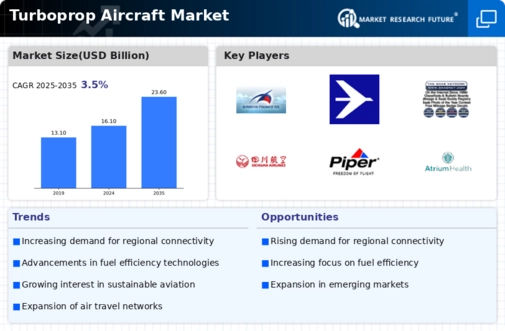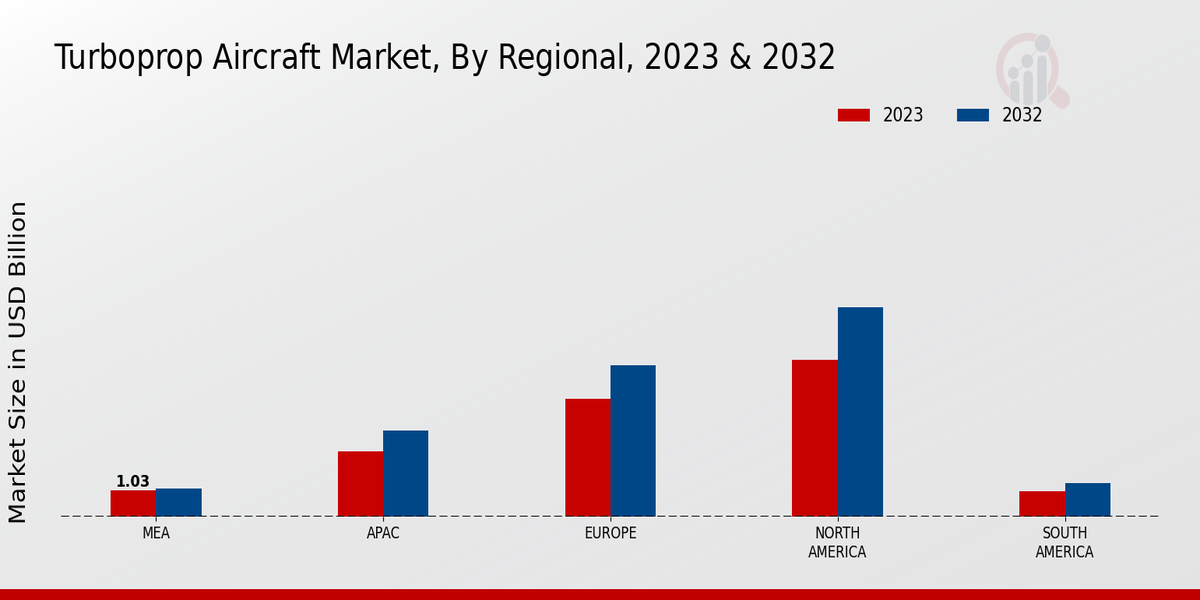Market Growth Projections
The Global Turboprop Aircraft Market Industry is poised for substantial growth, with projections indicating a rise from 16.1 USD Billion in 2024 to 23.6 USD Billion by 2035. This growth is underpinned by a compound annual growth rate (CAGR) of 3.52% from 2025 to 2035. The increasing demand for regional connectivity, coupled with the cost-effectiveness and technological advancements in turboprop aircraft, suggests a robust market outlook. As the aviation sector continues to evolve, the turboprop segment is likely to play a pivotal role in meeting the diverse needs of air travel.
Expansion of Regional Airlines
The expansion of regional airlines significantly impacts the Global Turboprop Aircraft Market Industry. As regional airlines proliferate, there is an increasing demand for aircraft that can efficiently serve short-haul routes. Turboprop aircraft, with their operational flexibility and cost advantages, are often the preferred choice for these airlines. The growth of regional carriers is expected to contribute to the market's expansion, as these airlines seek to enhance their fleets with modern turboprop models. This trend aligns with the overall growth trajectory of the market, which is projected to reach 23.6 USD Billion by 2035.
Growing Focus on Sustainable Aviation
The Global Turboprop Aircraft Market Industry is increasingly influenced by the growing focus on sustainable aviation practices. As environmental concerns gain prominence, manufacturers are exploring ways to reduce emissions and enhance fuel efficiency. Turboprop aircraft, with their inherent fuel efficiency, are positioned favorably in this context. The industry's commitment to sustainability is reflected in ongoing research and development efforts aimed at producing greener aircraft. This shift towards sustainability not only aligns with regulatory requirements but also resonates with environmentally conscious consumers, potentially driving market growth in the coming years.
Cost-Effectiveness of Turboprop Aircraft
Cost-effectiveness remains a pivotal driver in the Global Turboprop Aircraft Market Industry. Turboprop aircraft generally have lower operational costs compared to their jet counterparts, making them attractive for airlines operating regional routes. The lower fuel consumption of turboprops contributes to reduced overall expenses, which is particularly beneficial in an era of fluctuating fuel prices. Airlines can optimize their profit margins by utilizing turboprops, thus encouraging fleet diversification. This trend is likely to bolster the market's growth trajectory, as more operators recognize the financial advantages associated with turboprop operations.
Increasing Demand for Regional Connectivity
The Global Turboprop Aircraft Market Industry experiences a notable surge in demand for regional connectivity. As urbanization accelerates, there is a growing need for efficient air travel options that connect smaller airports to major hubs. Turboprop aircraft, known for their short takeoff and landing capabilities, are ideally suited for these routes. In 2024, the market is valued at 16.1 USD Billion, reflecting this trend. The ability of turboprops to operate in diverse environments enhances their appeal, potentially leading to an estimated market growth to 23.6 USD Billion by 2035, with a CAGR of 3.52% from 2025 to 2035.
Technological Advancements in Aircraft Design
Technological advancements play a crucial role in shaping the Global Turboprop Aircraft Market Industry. Innovations in aerodynamics, materials, and engine efficiency have led to the development of modern turboprop aircraft that offer enhanced performance and reduced environmental impact. For instance, advancements in composite materials have resulted in lighter airframes, improving fuel efficiency. Furthermore, the integration of advanced avionics systems enhances operational safety and efficiency. These technological improvements are likely to attract new operators and stimulate demand, contributing to the projected market growth from 16.1 USD Billion in 2024 to 23.6 USD Billion by 2035.





















